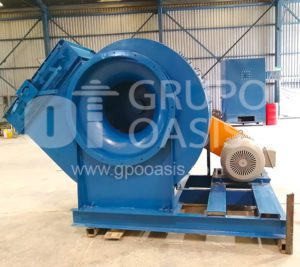Aire Ventilador centrífugo

BLOG
How to improve the air flow of your Centrifugal Fan?
mejorar aire ventilador centrífugo
Los diversos procesos de producción industrial y los Sistemas de Ventilación en las Plantas, en algunas ocasiones requieren incrementar el flujo de aire para el que originalmente fueron calculados los equipos, por ejemplo:
- Increase in production
- Readjustment of location at emission points
- Placement of new equipment
- Poor planning of equipment location in the plant
Check the mechanical conditions of your fan:
- Align and adjust the bands, making sure they are taut properly.
- Check the tolerance between the inlet cone and the rotor.
- Be sure to maintain and clean the fan.
- Verify that the rotor is working properly to specifications.
What to do then?
Check rotor rotation
The ventiladores centrífugos, durante su operación estarán moviendo el aire, aunque el rotor esté girando en sentido contrario.
Some equipment will demand more power, however others may be operating for years with no malfunction detected.
What is dust?
Dust generally consists of solid particles larger than one micron in diameter.
Particles larger than 1000 microns (1mm) are usually not considered fugitive, as they settle quickly and do not float in the air for long.
Particles smaller than one micron are considered fumes, since their behavior is more like gases than solids.
The most dangerous dust particles are those in the range of less than 10 microns, since they are breathable and can easily reach the interior of the lungs.
On the other hand, they have high surface areas per unit volume and are more combustible than larger particles.
El polvo, es en realidad un asunto de Salud, Seguridad y Finanzas para las empresas, ya que las consecuencias de un mal control de emisiones dentro y fuera la planta, les genera un alto costo anual, lo que se traduce en multas, ausentismo laboral por enfermedad, contaminación del ambiente, entre otras.

PorlvSolid particle powder with a diameter less than 500 micrómetrors
Grupo OASIS fabricamos colectores de polvos humos y neblinas. La versatilidad de nuestros Colectores de Polvos, Humos y Neblinas marca DYNAFLO®. brand, the attention to detail during the manufacturing and installation process allowed us to work in Mexico and United States.Nuestros clientes de las industrias agroalimentaria, cementera, química, cerámica, automotriz, acerera, entre otras más nos respaldan.Nuestra amplia gama de productos como colectores de polvos, colectores de humos, colectores de neblinas, ciclones, colectores de humos portátiles, ventiladores industriales, válvulas rotatorias, filtros y refacciones, además de proyectos llave en mano, capacitación y mantenimiento de equipos nos permiten brindar servicios integrales.
mejorar aire ventilador centrífugo. mejorar aire ventilador centrífugo
Filter cleaning system
The filtros en un Colector de Polvos, deben limpiarse periódicamente, ya que el polvo se acumula sobre la superficie de estos formando un “CAKE”, que hace la función de un pre-filtro del mismo filtro, lo que ocasiona un mal funcionamiento.
Eventually, this layer of dust (cake) increases the resistance of the air through the filters, decreasing the air volume capacity that is being handled in the system.
The equipment must have an automatic cleaning system (pulsejet), which pulses strong bursts of compressed air, through diaphragm valves that are sequentially actuated, by solenoid valves electrically actuated by a sequencer or solid-state TIMER.
The quality of compressed air is very important, so it must be monitored and cared for, it must be supplied clean and dry, at a pressure of between 90-100 Lbs / in²

Other articles of interest

Recommendations for ventilation of industrial buildings
Las naves industriales se caracterizan por sus grandes dimensiones, estas pueden adecuarse a las necesidades de distribución y espacio requeridos. Otro aspecto importante, es que deben contar con sistemas de…

What type of industrial ventilation system do I need for my company?
Ventilation systems are used to ventilate closed spaces in the industrial or commercial sector, their function is to regulate the temperature, renew the air, extract dust, smoke, mist or gases, prevent…

Types of Industrial Collectors
Industrial collector systems have their beginnings around 1886, their inventor was the engineer Wilhelm Friedrich Ludwig Beth, who was a mill builder like his father, Wilhelm Ludwig...






